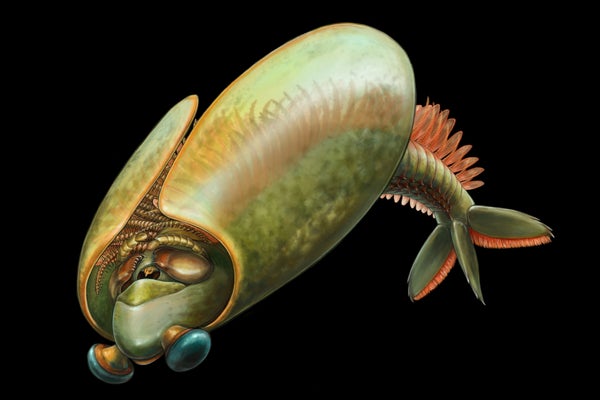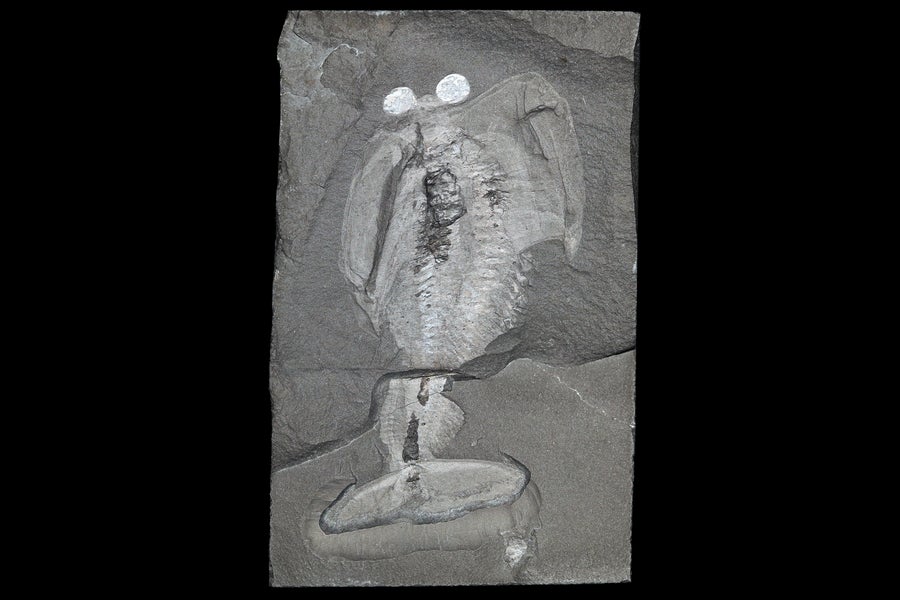500-Million-Year-Old ‘Alien Fish Taco’ Was among First Creatures with Jaws
A bizarre fossil of a Cambrian creature that looked like an “alien fish taco” reveals how a single group with jaws came to account for around 90 percent of all animal species on Earth

Odaraia (shown here in a life reconstruction) may have used it’s little spines to help bring food to its mouth. Researchers aren’t sure what the trident-shaped tooth in its mouth would have been used for.
Illustrated by Danielle Dufault. Courtesy Royal Ontario Museum
Around 500 million years ago a strange creature with bulging eyes, a rudderlike tail and 30 pairs of spiny limbs extending from its cigar-sized body swam through Earth’s seas. Most of its legs couldn’t touch the ocean floor because they were tucked inside a protective shell that wrapped almost entirely around its midsection. And like a tiny King Neptune, it wielded a mysterious trident-shaped tooth between external jawlike structures in front of its mouth.
Though it looked more like an alien fish taco, it was an arthropod called Odaraia alata. The creature, spanning about 20 centimeters long, likely met its end very suddenly, buried underneath a thick layer of sediment. But the circumstances that spelled the animal’s doom also immortalized it in the fossil record.
Paleontologists found the fossilized remains of several of these creatures in 1912 in the now famous Burgess Shale fossil site in the Canadian Rocky Mountains. The best-preserved Odaraia fossils were examined again in the 1970s and 1980s, but for several decades the specimens had remained in storage at the Royal Ontario Museum in Toronto.
On supporting science journalism
If you’re enjoying this article, consider supporting our award-winning journalism by subscribing. By purchasing a subscription you are helping to ensure the future of impactful stories about the discoveries and ideas shaping our world today.
Now scientists have taken a closer look at one with exquisitely preserved jaws using better tools and more modern techniques. They were particularly interested in its mandible’s connection to the Cambrian explosion, when a vast array of more advanced organisms burst onto Earth’s stage around 540 million years ago. Odaraia may have contributed to the modern-day dominance of creatures with mandibles, such as insects.

A fossil of an arthropod called Odaraia was discovered in 1912 in what is now called the Burgess Shale fossil site in the Canadian Rocky Mountains.
Jean-Bernard Caron, Royal Ontario Museum
“The evolution of the mandible ignited a feeding frenzy,” says Alejandro Izquierdo-López, an evolutionary biologist at the University of Toronto, who led the new study, published on July 23 in the Proceedings of the Royal Society B. “Animals with mandibles had a major edge over competing organisms [because they] could break larger structures into pieces and gain access to new types of food.”
With this special advantage, animals with mandibles quickly took over the planet, becoming Earth’s most diverse animal group. Particularly because of this dramatic success, scientists have long been interested in placing the mandible’s emergence on an evolutionary timeline. The O. alata fossil helps them do just that.
“First, we had to identify a Cambrian fossil that clearly showed the mandibles,” Izquierdo-López says. There had been some ambiguous identifications before, but the team suspected the O. alata fossil would be a better candidate. “These features are tiny, so we wanted to look at a relatively large creature from a site known for excellent preservation.” Finding them on such an old specimen––dating back close to the beginning of the arthropod fossil record, and which contains other very primitive features––confirms that these animals, part of the evolutionary family called odaraiids, were among the first to evolve mandibles. Animals with these mouthparts may have had an easy time shaping early food webs because ecosystems likely weren’t well developed.
Odaraia also had a second feeding advantage: its relatively large size. Most animals back then likely lived in small communities, seldom venturing far. A little creature would be restricted to such a community with a high enough concentration of particles for it to feed on. But a relatively large creature could feed more efficiently, so it wouldn’t be confined to the ocean’s denser pockets of life and food. Freed from the shackles of the seafloor, Odaraia individuals could roam the open sea as they pleased.
Until the recent study, scientists didn’t fully understand exactly how, or indeed whether, Odaraia could filter-feed. Derek Briggs, now a professor of earth and planetary sciences at Yale University, had initially inferred that odaraiidswere filter-feeders back in the early 1980s based on their strange form.
“It has no grasping limbs and the (then limited) evidence of the trunk limbs indicate that Odaraia could filter small animals by passing a flow of water through the carapace,” or shell-like covering, Briggs said in an e-mail to Scientific American. “The large eyes suggest that it might have sought out clouds of small animals (perhaps larval forms) in the water to feed on.”
The new study cracked the case of Odaraia’s filter-feeding mechanism by identifying about 80 tiny spines on each of the creature’s legs, which together created a sort of mesh that could capture particles.
Being a large filter-feeder and evolving a mandible gave Odaraia a double advantage that contributed to an evolutionary arms race, as it pressed other animals to adapt faster in response. Now scientists have set their sights on solving a new mystery: O. alata’s unexpected trident-shaped tooth. “It’s a structure that has not been seen in any other fossil from that time,” Izquierdo-López says. “We have no idea how they evolved or why they aren’t found in any other animal.”



